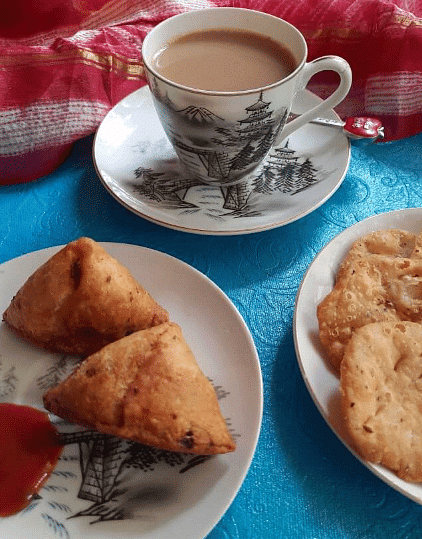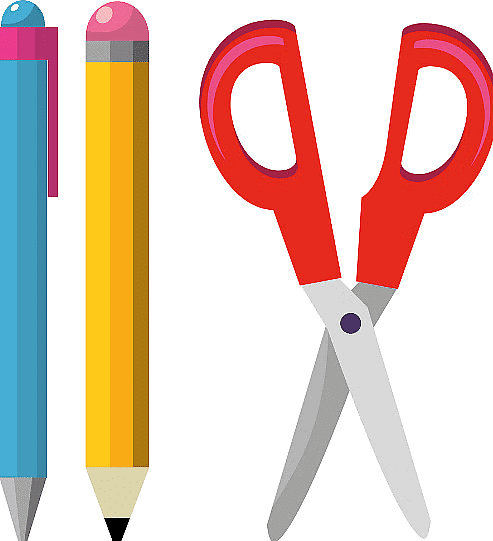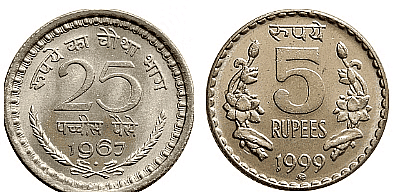Money Class 1 Worksheet Maths Chapter 12
Multiple Choice Questions
Q1: How much money would one need to buy a cup of coffee and two samosas if the price of the cup of coffee is Rs. 6 and each samosa costs Rs. 5?
(a) Rs. 12.50
(b) Rs. 16
(c) Rs. 11.50
(d) Rs. 13.50
Ans: (b)
Assuming the price of the cup of coffee is Rs. 6 and each samosa costs Rs. 5.
Total cost = Rs. 6 (coffee) + 2 × Rs. 5 (samosas) = Rs. 5 + Rs. 5 = Rs. 16.
Thus, Money needed is Rs. 16.
Q2: How much will a cup of tea, a packet of potato chips and a samosa cost if tea = Rs. 5, potato chips = Rs. 5 and samosa = Rs. 5.50?
 (a) Rs. 15.50
(a) Rs. 15.50
(b) Rs. 22.00
(c) Rs. 24.50
(d) Rs. 32.50
Ans: (a)
The prices of the items are:
Tea = Rs. 5
Potato chips = Rs. 5
Samosa = Rs. 5.50
When we add them together:
Total = Rs. 5 (tea) + Rs. 5 (chips) + Rs. 5.50 (samosa) = Rs. 15.50.
Q3: What is the choice of coins you may use for paying Rs. 7.25?
(a) Three 2-rupee coins, one 1-rupee coin and two 25-paisa coins
(b) Three 2-rupee coins, two 50-paisa coins and one 25-paisa coin.
(c) One 5-rupee coin and six 25-paisa coins
(d) One 5-rupee coin and 1-rupee coin and nine 25-paisa coins
Ans: (b)
To make Rs. 7.25, we can use:
Three 2-rupee coins = Rs. 6
Two 50-paisa coins = Rs. 1
One 25-paisa coin = Rs. 0.25
Total = Rs. 6 + Rs. 1 + Rs. 0.25 = Rs. 7.25.
Q4: Round Rs.1.78 to the nearest rupee.
(a) Rs.1.75
(b) Rs.2.0
(c) Rs.0.70
(d) Rs.1.00
Ans: (b)
When rounding Rs. 1.78 to the nearest rupee, the digit after the decimal point is 7, which rounds it up to Rs. 2. Thus, the correct answer is Rs. 2.0.
Q5: Megha bought one pen for Rs.5.65, a pair of scissors for Rs.1.55, a folder for Rs.5.80 and a bag for Rs.3.50. She pays 20 rupees for the above items. What will she get as her change?
 (a) Rs. 3.50
(a) Rs. 3.50
(b) Rs. 2.50
(c) Rs. 2
(d) Rs.3
Ans: (a)
Total cost of items:
Pen = Rs. 5.65
Scissors = Rs. 1.55
Folder = Rs. 5.80
Bag = Rs. 3.50
Total = Rs. 5.65 + Rs. 1.55 + Rs. 5.80 + Rs. 3.50 = Rs. 16.50.
Amount paid = Rs. 20.
Change = Rs. 20 - Rs. 16.50 = Rs. 3.50.
Thus, the correct answer is Rs. 3.50.
Q6: Madhavi earned Rs. 180 for mowing her uncle’s lawn all summer. If her uncle paid Rs. 15 each time she mowed, how many times did she mow?
(a) 168
(b) 60
(c) 24
(d) 12
Ans: (d)
To find the number of times Madhavi mowed, divide the total earnings by the payment per mowing:
Number of times = Rs. 180 ÷ Rs. 15 = 12.
Thus, the correct answer is 12.
Q7: Which of these costs more?
(a) Samosas
(b) 2 packets of potato chips
(c) 2 soft drinks
(d) 3 sandwiches
Ans: (c)
Samosa costs Rs. 5 each.
2 packets of potato chips cost Rs. 5 each, totaling Rs. 10.
2 soft drinks cost Rs. 20 each, totaling Rs. 40.
3 sandwiches cost Rs. 10 each, totaling Rs. 30.
From this, 2 soft drinks (Rs. 40) cost the most among the options. Thus, the correct answer is:
Answer: (c) 2 soft drinks
Q8: How many 25-paisa coins will you get for a 5-rupe coin?
 (a) 15
(a) 15
(b) 20
(c) 25
(d) 30
Ans: (b)
A 5-rupee coin is equivalent to 500 paisa (since 1 rupee = 100 paisa).
To get 500 paisa, we can use 20 coins of 25 paisa (20 × 25 paisa = 500 paisa).
Thus, the correct answer is 20.
Q9: Tosh buys a pair of gloves for Rs.20.50. What combination of the coins should he give the cashier?
(a) 4 five Rs. notes, 2 fifty p coins, 3 twenty five p coins & 1 ten p coin
(b) 2 ten Rs. notes, 3 fifty p coins, 1 twenty five p coin & 1 ten p coin
(c) 3 five Rs. notes, 8 fifty p coins, 5 twenty five p coin, 2 ten p coins & 1 five p coin
(d) 3 five Rs. notes, 8 fifty p coins, 5 twenty five p coin, 1 ten p coins & 2 five p coin
Ans: (c)
To pay Rs. 20.50, Tosh can use:
3 five-rupee notes = Rs. 15
8 fifty-paisa coins = Rs. 4
5 twenty-five-paisa coins = Rs. 1.25
2 ten-paisa coins = Rs. 0.20
1 five-paisa coin = Rs. 0.05
Total = Rs. 15 + Rs. 4 + Rs. 1.25 + Rs. 0.20 + Rs. 0.05 = Rs. 20.50.
Q10: Nidhi bought a pair of sunglasses for Rs.11.87 and a belt for Rs.3.99. The sales tax was Rs.1.14. Nidhi gave 20 Rs. note to the cashier. How much change should she get back?
(a) Rs.3.25
(b) Rs.3
(c) Rs.3.09
(d) Rs.3.50
Ans: (b)
Total cost = Rs. 11.87 (sunglasses) + Rs. 3.99 (belt) + Rs. 1.14 (sales tax) = Rs. 17.00.
Amount given = Rs. 20.
Change = Rs. 20 - Rs. 17.00 = Rs. 3.
Thus, the correct answer is Rs. 3.
|
33 videos|241 docs|30 tests
|
FAQs on Money Class 1 Worksheet Maths Chapter 12
| 1. What are the different types of currency used around the world? |  |
| 2. How can I effectively manage my money? |  |
| 3. What are the benefits of saving money? |  |
| 4. How do interest rates affect my savings? |  |
| 5. What are some common ways to invest money? |  |
















